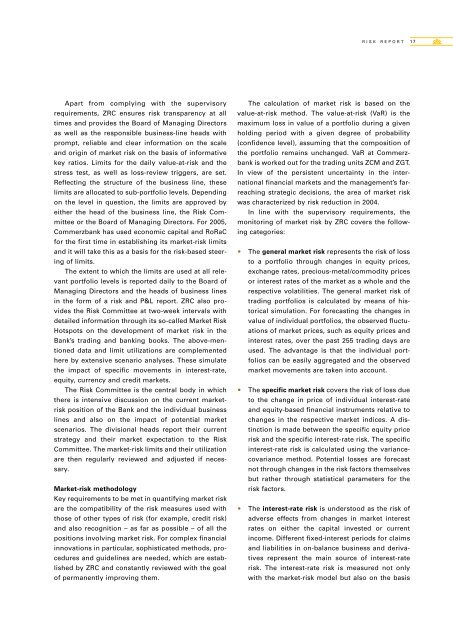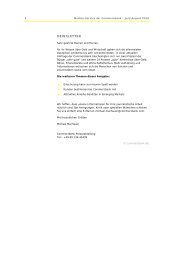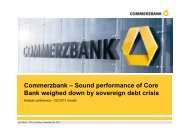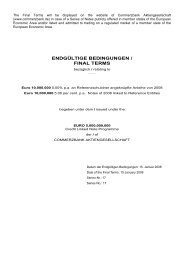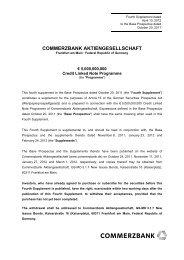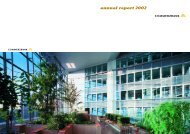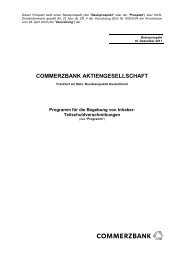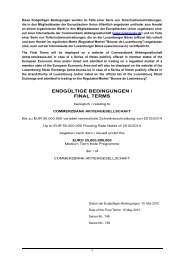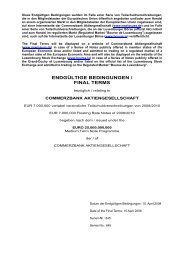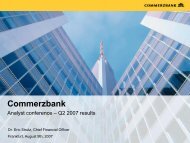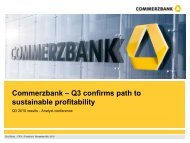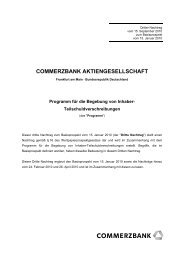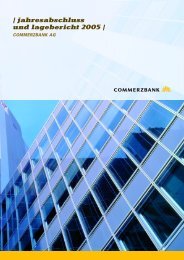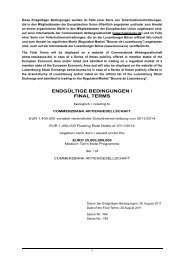financial statements and management report 2004 commerzbank ag
financial statements and management report 2004 commerzbank ag
financial statements and management report 2004 commerzbank ag
You also want an ePaper? Increase the reach of your titles
YUMPU automatically turns print PDFs into web optimized ePapers that Google loves.
Apart from complying with the supervisory<br />
requirements, ZRC ensures risk transparency at all<br />
times <strong>and</strong> provides the Board of Man<strong>ag</strong>ing Directors<br />
as well as the responsible business-line heads with<br />
prompt, reliable <strong>and</strong> clear information on the scale<br />
<strong>and</strong> origin of market risk on the basis of informative<br />
key ratios. Limits for the daily value-at-risk <strong>and</strong> the<br />
stress test, as well as loss-review triggers, are set.<br />
Reflecting the structure of the business line, these<br />
limits are allocated to sub-portfolio levels. Depending<br />
on the level in question, the limits are approved by<br />
either the head of the business line, the Risk Committee<br />
or the Board of Man<strong>ag</strong>ing Directors. For 2005,<br />
Commerzbank has used economic capital <strong>and</strong> RoRaC<br />
for the first time in establishing its market-risk limits<br />
<strong>and</strong> it will take this as a basis for the risk-based steering<br />
of limits.<br />
The extent to which the limits are used at all relevant<br />
portfolio levels is <strong>report</strong>ed daily to the Board of<br />
Man<strong>ag</strong>ing Directors <strong>and</strong> the heads of business lines<br />
in the form of a risk <strong>and</strong> P&L <strong>report</strong>. ZRC also provides<br />
the Risk Committee at two-week intervals with<br />
detailed information through its so-called Market Risk<br />
Hotspots on the development of market risk in the<br />
Bank’s trading <strong>and</strong> banking books. The above-mentioned<br />
data <strong>and</strong> limit utilizations are complemented<br />
here by extensive scenario analyses. These simulate<br />
the impact of specific movements in interest-rate,<br />
equity, currency <strong>and</strong> credit markets.<br />
The Risk Committee is the central body in which<br />
there is intensive discussion on the current marketrisk<br />
position of the Bank <strong>and</strong> the individual business<br />
lines <strong>and</strong> also on the impact of potential market<br />
scenarios. The divisional heads <strong>report</strong> their current<br />
strategy <strong>and</strong> their market expectation to the Risk<br />
Committee. The market-risk limits <strong>and</strong> their utilization<br />
are then regularly reviewed <strong>and</strong> adjusted if necessary.<br />
Market-risk methodology<br />
Key requirements to be met in quantifying market risk<br />
are the compatibility of the risk measures used with<br />
those of other types of risk (for example, credit risk)<br />
<strong>and</strong> also recognition – as far as possible – of all the<br />
positions involving market risk. For complex <strong>financial</strong><br />
innovations in particular, sophisticated methods, procedures<br />
<strong>and</strong> guidelines are needed, which are established<br />
by ZRC <strong>and</strong> constantly reviewed with the goal<br />
of permanently improving them.<br />
RISK REPORT 17<br />
The calculation of market risk is based on the<br />
value-at-risk method. The value-at-risk (VaR) is the<br />
maximum loss in value of a portfolio during a given<br />
holding period with a given degree of probability<br />
(confidence level), assuming that the composition of<br />
the portfolio remains unchanged. VaR at Commerzbank<br />
is worked out for the trading units ZCM <strong>and</strong> ZGT.<br />
In view of the persistent uncertainty in the international<br />
<strong>financial</strong> markets <strong>and</strong> the <strong>man<strong>ag</strong>ement</strong>’s farreaching<br />
strategic decisions, the area of market risk<br />
was characterized by risk reduction in <strong>2004</strong>.<br />
In line with the supervisory requirements, the<br />
monitoring of market risk by ZRC covers the following<br />
categories:<br />
The general market risk represents the risk of loss<br />
to a portfolio through changes in equity prices,<br />
exchange rates, precious-metal/commodity prices<br />
or interest rates of the market as a whole <strong>and</strong> the<br />
respective volatilities. The general market risk of<br />
trading portfolios is calculated by means of historical<br />
simulation. For forecasting the changes in<br />
value of individual portfolios, the observed fluctuations<br />
of market prices, such as equity prices <strong>and</strong><br />
interest rates, over the past 255 trading days are<br />
used. The advant<strong>ag</strong>e is that the individual portfolios<br />
can be easily <strong>ag</strong>gregated <strong>and</strong> the observed<br />
market movements are taken into account.<br />
The specific market risk covers the risk of loss due<br />
to the change in price of individual interest-rate<br />
<strong>and</strong> equity-based <strong>financial</strong> instruments relative to<br />
changes in the respective market indices. A distinction<br />
is made between the specific equity price<br />
risk <strong>and</strong> the specific interest-rate risk. The specific<br />
interest-rate risk is calculated using the variancecovariance<br />
method. Potential losses are forecast<br />
not through changes in the risk factors themselves<br />
but rather through statistical parameters for the<br />
risk factors.<br />
The interest-rate risk is understood as the risk of<br />
adverse effects from changes in market interest<br />
rates on either the capital invested or current<br />
income. Different fixed-interest periods for claims<br />
<strong>and</strong> liabilities in on-balance business <strong>and</strong> derivatives<br />
represent the main source of interest-rate<br />
risk. The interest-rate risk is measured not only<br />
with the market-risk model but also on the basis


